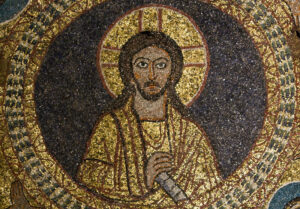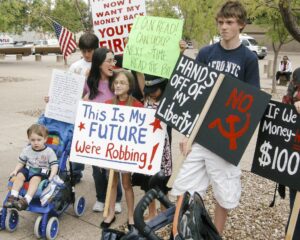Two classic books published in 1952 dominated this field for a generation, summarizing opposite traditions of assessment yielding a similar verdict. Political scientist Ira Kipnis, in The American Socialist Movement, argued that the Socialist Party was doomed from the beginning by its accommodating social democratic reformism. Kipnis said the right wing of the party led by Milwaukee journalist-politician Victor Berger was consumed with winning elections and the mainstream of the party led by New York journalist-politician Morris Hillquit was only slightly less opportunistic. The party debated immediate demands and true Marxism at its founding, but adopted the wrong answer. It got a second chance at correcting its course in 1905 when the Industrial Workers of the World (IWW) was founded, but Eugene Debs did not stick with the IWW and most of the party loathed the anarcho-syndicalism and violence of the IWW.
The party lost its last chance of becoming important when it censured its left flank of IWW members in 1912 and expelled IWW leader Bill Haywood from the Executive Committee the following year. Kipnis contributed mightily to the legend that the IWW Wobblies were the real thing and the flanks led by Hillquit and Berger were sellouts. The real thing was anarchist in hating government and syndicalist in contending that worker syndicates should run the country. True leftism versus opportunism explained the failure of the Socialist Party, culminating in the Haywood drama. Had Kipnis peaked ahead to World War I, he would have had to explain how it was that Hillquit and Berger stoutly opposed the war while nearly all its intellectuals—some of them true-believing left-wingers–capitulated to it.1
Sociologist Daniel Bell, in Marxian Socialism in the United States, agreed from an opposite standpoint that the party was hopelessly futile from the beginning, contending that every Socialist leader espoused a utopian vision of social transformation that made the party alien to American society and marginal in it. According to Bell, AFL leader Samuel Gompers was the wise hero who figured out how to make social democratic gains in capitalist America, whereas Debs, Hillquit, and Berger clung to an un-American fantasy. Subsequently the Socialist Party crawled onward at the national level only because it had a compelling figurehead, Thomas. Just as Kipnis looked down on his subject from the superior vantage point of pro-Communist radicalism, Bell looked down as a Cold War liberal, having recently outgrown his youthful attachment to Norman Thomas Socialism. The Socialists, Bell said, were ideologues in a pluralistic and technocratic society that eventually put an end to ideology itself.2
◆◆◆
“Alabama Communists came from the working class, had little or no connection to Euro-American traditions of radical politics, and consisted mostly of religious black wage earners and sharecroppers, housewives, and renegade liberals.”
◆◆◆
These rival books cast a long shadow over scholarship on the American Left. The fact that they drove to the same conclusion about the futility of American democratic socialism solidified this verdict as a convention. Cold War liberalism, combining anti-Communist containment and the domestic reforms of the New Deal, dominated the scholarship and politics of the 1950s and early 1960s. To render the legacy of American democratic socialism less negatively, one had to take the Kipnis and Bell outcome for granted while alleviating the story of their harshness. Two political historians, Howard Quint and David Shannon, took this approach in the mid-1950s, winsomely playing up that a remarkable array of Americans identified with the Socialist Party over the decades.
Quint, in The Forging of American Socialism (1953), and Shannon, in The Socialist Party of America (1955), suggested that American democratic socialism could not have been such a hopeless idea if it attracted so many prairie Populists, Jewish garment workers, Protestant clerics, old-American patricians, and sewer socialists. Quint covered the period between 1865 and 1901, and Shannon from 1901 to 1950. They got the main thing right without grasping the defining sociological weakness of the party. The Socialist Party was a social movement bound by an ideology and a very weak organizational structure. It was never an organized political party that overcame its factional disputes, and its ideological separatism thwarted the labor party option back when it was a real option. Quint and Shannon eschewed interpretation to the point of failing to explain what went wrong for American democratic socialists; presumably, what went wrong was self-evident.3
Many scholars specialized in the ostensibly more important subject, American Communism. In 1957 political historian Theodore Draper, a former correspondent in the 1930s for the Communist Daily Worker, wrote a pioneering, detailed, astute, and devastating insider history, Roots of American Communism. Draper argued that the Communist Party surpassed the Socialist Party because it slavishly carried out every shift, reversal, alliance, and conspiracy ordered by its masters in Moscow. This was a story of orders transmitted by Kremlin bosses to their compliant servants in New York. Whatever laudable things that American Communists did—defending the poor, supporting black Americans, helping to found the CIO, trying to create a Farmer-Labor party—were incidental by comparison. Communists, whenever so ordered, were willing to reverse direction, sabotage unions and coalitions, and lie about anything, especially their own politics.
Draper portrayed American Communism as more evil than stupid. Socialism was deeply alien to American society, exactly as Bell said, and the only kind that succeeded in America was totalitarian, never mind that Communist and pro-Communist dupes shielded themselves from realizing what sort of outfit they defended. Many scholars amplified Draper’s picture of America’s homegrown Communist menace, notably Shannon, Irving Howe, Lewis Coser, Nathan Glazer, and Harry Overstreet. Nearly always they came from Socialist, pro-Communist, or Communist backgrounds themselves, citing former Communists who became professional anti-Communists. Jay Lovestone and Benjamin Gitlow, upon falling from the top of the American Communist hierarchy, were pioneers of the former-Communist anti-Communist genre; later there were many others, notably James Burnham, Max Eastman, and Whittaker Chambers.4
Scholarship on American Communism shifted dramatically when scholars applied the social history approach to it, focusing on Communists who never got a directive from Moscow. Maurice Isserman wrote the breakthrough social history, Which Side Were You On? (1982), reinterpreting the role of American Communism in the Popular Front campaigns of the 1930s and 1940s. Isserman contended that Communists fled the party in the late 1950s because the Cold War abolished any prospect of a new Popular Front, not because they were disillusioned by Soviet rule at the Draper level. A gusher of social histories ensued, usually focusing on black Communists and the CIO unions, where Communists controlled or exercised dominant influence in 15 internationals numbering approximately 1.4 million members.
Ronald Schatz, Mark Naison, Bruce Nelson, Robin D. G. Kelley, and Michael Goldfield were pioneers of the social history genre. Kelley’s Hammer and Hoe: Alabama Communists During the Great Depression (1990) made a seminal contribution, detailing the struggles of Alabama Communists against the racist police state of Alabama in the 1930s and ‘40s. Kelley stressed that Alabama Communists came from the working class, had little or no connection to Euro-American traditions of radical politics, and consisted mostly of religious black wage earners and sharecroppers, housewives, and renegade liberals. Reflecting on the chasm between black Alabama Communists and the party bosses in New York, Kelley noted aptly that if black Alabamans had waited “patiently for orders from Moscow, they might still be waiting today.”5
American democratic socialism exploded under the Communist eruption of 1919, fought American Communism at the Draper level for decades, and fell behind the Communists in the 1930s in racial justice activism and organizing CIO unions. The New Left revisionism that famously disputed Cold War liberalism in the 1960s and yielded the social histories of the 1980s extended to how the early Socialist Party should be understood. Political historian James Weinstein was the leading New Left revisionist about the Socialist Party. In The Decline of Socialism in America (1967), he contended that Kipnis and Bell were too prejudiced against their subject to get it right.
Kipnis said the sellout leaders who opposed Haywood sealed the party’s fate; Bell said Woodrow Wilson’s liberalism sealed the party’s fate, making socialism irrelevant in American life; Weinstein showed that Socialist activism increased after the anarcho-syndicalists bolted and Wilson entered the White House, contrary to Kipnis and Bell. Moreover, none of the party’s leftwing leaders (Debs, Ella Reeve Bloor, Louis Boudin, Emil Herman, Kate O’Hare, Charles Ruthenberg, and Rose Pastor Stokes) or its leading leftwing intellectuals (Frank Bohn, Jack London, J. G. Phelps-Stokes, and William English Walling) dropped their Socialist politics.6
◆◆◆
“The Socialist Party outperformed all its European counterparts in the electoral arena up to 1918 despite its small size and union base.”
◆◆◆
I take the latter point from Weinstein while stressing that American socialism never acquired anywhere near the labor movement base of the British Labour Party and the Continental Social Democratic parties. The early Socialist Party was too extraordinary for its own good, combining so many ethnic groups, regional cultures, and social movements that Debs and Hillquit saw no need to ally with anybody except on Socialist terms, while Debs and Haywood castigated the entire AFL as a corrupt sellout. Even after the party lost the Haywood anarcho-syndicalists, it remained a thriving political force that improved its record on racial justice, supported the rights of women, and welcomed a gusher of immigrants. The party’s early factionalism gave way to a more coherent democratic socialism, to the extent that such a thing was possible in a ramshackle federalist structure, and Debs forged a genuine friendship and political bond with Hillquit. The Socialist Party outperformed all its European counterparts in the electoral arena up to 1918 despite its small size and union base. The vicious government persecution of the party for its antiwar stand might have been enough to cripple it irreparably; as it was the Communist eruption tore apart the entire Socialist world. The American Communist Party arose at the expense of the Socialist Party it devastated.
The Vital Role of Christian Socialism
Most historical scholarship on American democratic socialism underplays the importance of racism and black Socialists, feminism and feminist Socialists, and religious socialism, and thus misses as well how these subjects relate to each other. I am grateful to scholars who have addressed one or more of these issues. Sally Miller and Mary Jo Buhle wrote pioneering works on women in the Socialist Party, filling a crucial gap; Jack Ross extended Weinstein’s basic story line about the Socialist Party and added an appreciative twist about the Old Guard; Heath W. Carter superbly detailed the working-class roots of the social gospel in Chicago, highlighting Catholic unionists; Philip S. Foner was the first scholar to give George W. Woodbey and other black socialists their due. The socialist contention that all forms of oppression are secondary to the class struggle naturally yielded accounts of white male Socialists saying so. But Christian socialism was not a latecomer in the United States, it spread across the entire nation, and it did not take a back seat to non-religious socialism.7
◆◆◆
“Most of the women who came into the socialist movement came through social gospel socialism.”
◆◆◆
Most of the women who came into the socialist movement came through social gospel socialism. The U.S. was like Britain in producing vital Christian socialist traditions that spoke to broader middle-class audiences than the Socialist parties, demanded to be included in Socialist politics, built significant organizations, and outlasted the Marxist traditions. Kipnis dismissed the Christian socialists in three quick strokes, noting that George Herron was briefly famous, something called the Christian Socialist Fellowship existed, and all Christian socialists, being religious, were of course opportunists. On occasion Kipnis cited a Christian Socialist cleric saying something moralizing about public morality. Christian socialism itself he dispatched with a single sentence: “Since the Christian Socialists based their analysis on the brotherhood of man rather than on the class struggle, they aligned themselves with the opportunist rather than the revolutionary wing of the party.” The party’s many Christian socialist leaders and authors, whoever they were, could not have mattered, since they were religious.8
Bell similarly pushed aside the Christian Socialists, without employing “opportunist” as a broad-brush epithet. He devoted a footnote to the Christian Commonwealth colony at Commonwealth, Georgia, noted that Edward Bellamy’s Fabian nationalist utopia Looking Backward (1888) won most of its fame through Christian socialist clergy, and observed that a cleric named George Herron was “one of the leading figures of the party.”



